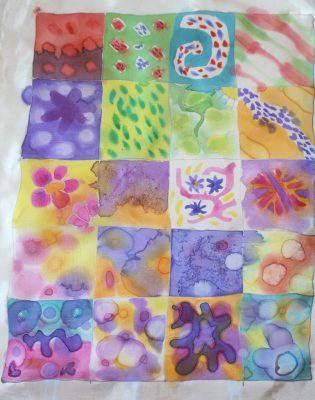Today I decided to skip both dyeing and weaving and try my hand at silk painting using Lanaset dyes. And here is the result:

Obviously there is no great artistic theme to this; I was just playing with tools and techniques. But it was quite interesting, and quite educational. I experimented with gutta (resist), with different dyes, with mixing alcohol into the dyes, anti-diffusant, dripping alcohol on wet and dry dyes, overpainting, adding salt, and, uh, stuff. Lots of stuff. 20 squares worth of stuff, as it happens.
This was a profoundly different experience from my first attempt at silk painting about fifteen years ago. I went into it, as many beginners do, with the idea that I was going to paint something just like that beautiful portrait of bearded irises on the cover of the book. Of course I didn’t have the skills to do that, and I got progressively more frustrated with my incompetence and finally put it aside for easier things.
I mention this because I have heard many, many teachers decry the “shallow” approach of beginners today, who come in with no experience and expect to be able to do work at the teacher’s level, then get frustrated when they can’t do it, and then leave. They feel that this reflects an “instant gratification” culture.
I don’t see it that way at all. The perfectly natural reaction to seeing something cool and beautiful is, “Ooh, I’d LOVE to be able to do something like that!” And, if you’ve never made anything before, you have no idea how complicated and difficult creating that cool and beautiful item can be. So students are naturally going to show up in class with inflated expectations. And many of them, discovering that at least several years of intense study are required to duplicate that nifty whatever-it-was, are going to leave. (Or – more frustratingly for the teacher – ask the teacher to hand-hold them, and/or do the hard parts for them.)
What I discovered in my first attempt at silk-painting was that my expectations were far above my skills. I got frustrated. I left. And I didn’t come back for a good fifteen years.
This time is different. Why? A couple of things:
First, I’m much less results-oriented than I was before. I don’t know where I’m going with this. I don’t know what I want to do with silk painting. And so, instead of saying “I want to make a beautiful painting of bearded irises, just like the ones on the cover of the book,” I’m saying, “Let’s find out what happens when I drip rubbing alcohol on an already-dry, already-painted section. Let’s find out what happens if I sprinkle on a little salt.” I’m exploring, I’m playing, but I have no end goal in mind.
Second, I have a much more realistic idea of the skills that are needed. I’m no longer fooled by the beautiful photos in the book: they’re not realistic, they’re just advertising (or inspiration, if you prefer). They were done by someone who specializes in that kind of work and probably has 10-20 years of experience in it. While it’s certainly not beyond me to create that kind of work, my skills are nowhere near that level, and if I want to create those, I need to develop the skills first. So I am less frustrated because I know it’s out of my reach, for now.
Third, I’m being much more disciplined in my approach. Instead of leaping straight for the candy (making pretty pictures), I’m laying the foundation by figuring out what my tools and my medium do and don’t do. If you look at the photo, you’ll see a mishmash of techniques being tested, everything from overpainting to antidiffusant to simply blending multiple colors. And you’ll see a few design ideas, but nothing too grandiose. I’m laying down fundamentals here, not trying to be the next Van Gogh.
And fourth, I’m not approaching it in a vacuum, but seeing it as part of an interrelated family of skills: composition, use of color, watercolor painting techniques, dyeing techniques, and of course techniques specific to silk painting. In this approach, it does not matter if I can’t draw bearded irises worth squat; I’m developing transferable skills that will aid me in a wide variety of artistic endeavors. This is a much broader (and some might say deeper) approach to fiber arts: building up skills slowly, over time, identifying deficiencies and seeking to remedy them, one at a time, instead of attempting everything at once.
That, I would say, is the distinction between the complete novice and the more experienced “maker”: the understanding that creation is a journey, that the development of fundamentals is a prerequisite to arias, and that no knowledge is ever wasted – what you learn today is just part of your artistic journey, and will broaden and deepen your approach to creation, throughout your entire life.